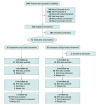Effect of Early vs Delayed Surgical Treatment on Motor Recovery in Incomplete Cervical Spinal Cord Injury With Preexisting Cervical Stenosis: A Randomized Clinical Trial
- PMID: 34751757
- PMCID: PMC8579238
- DOI: 10.1001/jamanetworkopen.2021.33604
Effect of Early vs Delayed Surgical Treatment on Motor Recovery in Incomplete Cervical Spinal Cord Injury With Preexisting Cervical Stenosis: A Randomized Clinical Trial
Erratum in
-
Error in Figure 3.JAMA Netw Open. 2021 Dec 1;4(12):e2143306. doi: 10.1001/jamanetworkopen.2021.43306. JAMA Netw Open. 2021. PMID: 34910157 Free PMC article. No abstract available.
Abstract
Importance: The optimal management for acute traumatic cervical spinal cord injury (SCI) is unknown.
Objective: To determine whether early surgical decompression results in better motor recovery than delayed surgical treatment in patients with acute traumatic incomplete cervical SCI associated with preexisting canal stenosis but without bone injury.
Design, setting, and participants: This multicenter randomized clinical trial was conducted in 43 tertiary referral centers in Japan from December 2011 through November 2019. Patients aged 20 to 79 years with motor-incomplete cervical SCI with preexisting canal stenosis (American Spinal Injury Association [ASIA] Impairment Scale C; without fracture or dislocation) were included. Data were analyzed from September to November 2020.
Interventions: Patients were randomized to undergo surgical treatment within 24 hours after admission or delayed surgical treatment after at least 2 weeks of conservative treatment.
Main outcomes and measures: The primary end points were improvement in the mean ASIA motor score, total score of the spinal cord independence measure, and the proportion of patients able to walk independently at 1 year after injury.
Results: Among 72 randomized patients, 70 patients (mean [SD] age, 65.1 [9.4] years; age range, 41-79 years; 5 [7%] women and 65 [93%] men) were included in the full analysis population (37 patients assigned to early surgical treatment and 33 patients assigned to delayed surgical treatment). Of these, 56 patients (80%) had data available for at least 1 primary outcome at 1 year. There was no significant difference among primary end points for the early surgical treatment group compared with the delayed surgical treatment group (mean [SD] change in ASIA motor score, 53.7 [14.7] vs 48.5 [19.1]; difference, 5.2; 95% CI, -4.2 to 14.5; P = .27; mean [SD] SCIM total score, 77.9 [22.7] vs 71.3 [27.3]; P = .34; able to walk independently, 21 of 30 patients [70.0%] vs 16 of 26 patients [61.5%]; P = .51). A mixed-design analysis of variance revealed a significant difference in the mean change in ASIA motor scores between the groups (F1,49 = 4.80; P = .03). The early surgical treatment group, compared with the delayed surgical treatment group, had greater motor scores than the delayed surgical treatment group at 2 weeks (mean [SD] score, 34.2 [18.8] vs 18.9 [20.9]), 3 months (mean [SD] score, 49.1 [15.1] vs 37.2 [20.9]), and 6 months (mean [SD] score, 51.5 [13.9] vs 41.3 [23.4]) after injury. Adverse events were common in both groups (eg, worsening of paralysis, 6 patients vs 6 patients; death, 3 patients vs 3 patients).
Conclusions and relevance: These findings suggest that among patients with cervical SCI, early surgical treatment produced similar motor regain at 1 year after injury as delayed surgical treatment but showed accelerated recovery within the first 6 months. These exploratory results suggest that early surgical treatment leads to faster neurological recovery, which requires further validation.
Trial registration: ClinicalTrials.gov Identifier: NCT01485458; umin.ac.jp/ctr Identifier: UMIN000006780.
Conflict of interest statement
Figures



References
-
- Tator CH, Benzel EC, eds. Contemporary Management of Spinal Cord Injury: From Impact to Rehabilitation. 2nd ed. The American Association of Neurological Surgeons; 2000.
-
- National Spinal Cord Injury Statistical Center . Spinal cord injury facts and figures at a glance. Accessed July 30, 2021. https://www.nscisc.uab.edu/Public/Facts%20and%20Figures%202020.pdf

